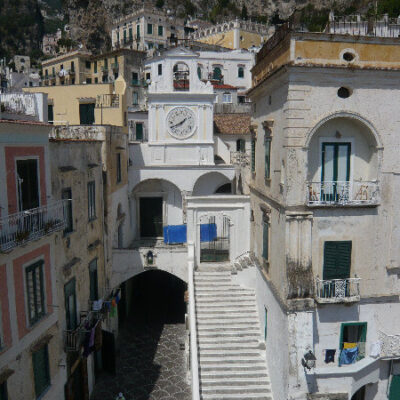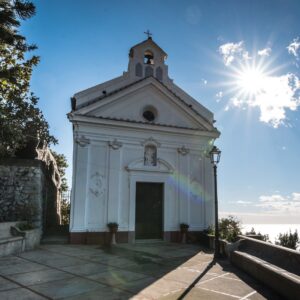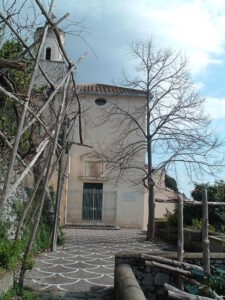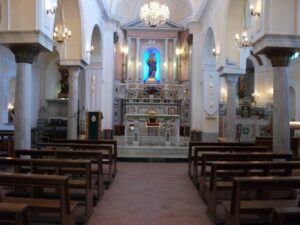MUNICIPALITY: Atrani
NAME: Church of S. Salvatore “de platea” or “de birecto”
LOCATION: Piazza Umberto I
DESCRIPTION: The church turns out to be important in the political history of the Maritime Republic of Amalfi, because here the doges received investiture and were buried. It dates back to 940 and almost immediately became a palatine chapel. Over the centuries it has undergone considerable transformations, not only in the elevations, but also in the plan, which a very careful restoration is remedying.
It has three naves, with an altar on the east side and the main entrance on the right side nave, which opens onto a small atrium accessed by stairs from the square.
The roof is vaulted and the restoration site is uncovering interesting new features. Two pointed arches have been discovered there where the sacristy once existed, giving the structure a completely new form (this recovered room must have been semi-open and dated back to the 13th century); in addition, part of the left nave appears to have been demolished toward the north, while at the height of the altar it presents a second entrance.
The church does not have a proper facade except for a side superstructure, divided into two floors, of which the upper and more interesting one shows a clock framed by two pilasters on each side, with Ionic capitals, and ending with a gabled structure that acts as a belfry, defined in the low side area by two volutes.
Of interest is the bronze door, commissioned by Pantaleone di Viarecta, in 1076, consisting of 24 panels, four of which (the central ones) show Christ, the Virgin, St. Pantaleon and St. Sebastian, while the other twenty reproduce ageminate and leafy crosses (croci ageminate e fogliate*).
The door, originally intended for the no longer existing church of St. Sebastian, is stylistically related to other bronze doors on the Coast, especially with that of Amalfi Cathedral. The panels are held together on a wooden frame (a second door) by continuous joining elements.
Also preserved here is a pluteus (12th century) made of marble, without epigraphs, but with a very intricate decoration: the largest field is occupied by two peacocks, seen from the front, with their tails and wings open and divided by a tree trunk, at the top of which is a brooding bird; the peacock on the left rests on the head of a man surrounded by two mermaids, the one on the right holds a hare, contended by two birds, with its paws.
SEE, VISIT, FIND: The church was a few months ago (April 2012) reopened to the public after a long period of restoration. It is possible to visit it on the occasion of liturgical celebrations or by agreeing with the pastors of the Collegiate Church of St. Maria Maddalena on a different time.
FRUITION DATA: None.
OPPORTUNITY: The church, because of its importance, should be made usable and included in a circuit of visits dedicated to the most important places of the Maritime Republic period. Illustrative signage of the architectural and artistic features of the site could also be used, especially while waiting for the opening of the facilities to the public.
BIBLIOGRAPHY: CAFFARO A. – GARGANO G. , Costiera Amalfitana, guida storico-artistica, Salerno 1979.
BRACA A., Le culture artistiche del Medioevo in Costa d’Amalfi, Amalfi 2003.
PROSPERETTI F.- SABINO L., Il Restauro della chiesa del SS. Salvatore “de birecto” di Atrani, prime scoperte, in (a c.) R. FIORILLO- P. PEDUTO, III Congresso nazionale di Archeologia medievale, Salerno 2003.





